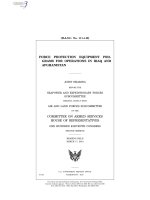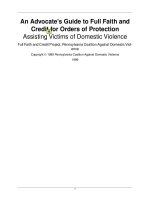VETIVER GRASS FOR RIVER BANK PROTECTION
Bạn đang xem bản rút gọn của tài liệu. Xem và tải ngay bản đầy đủ của tài liệu tại đây (260.62 KB, 14 trang )
VETIVER GRASS FOR RIVER BANK PROTECTION
D.J. Jaspers-Focks and A. Algera
Delft University of Technology, C.B. van Bossestraat 11, 5612 SC Eindhoven,
The Netherlands
ABSTRACT
In many parts of the world, bank failure in rivers, canals and other waterways is a major
concern for engineers and also for environmental reasons. Erosion results in loss of land and it
threatens dikes. These problems tend to become even bigger due to a lack of effective erosion
controls, an ever increasing intensity of boat traffic and a change in hydraulic boundary
conditions. An economically attractive and readily available solution might be the application
of the Vetiver System using Vetiver grass. However, the influence of Vetiver grass on the
physical processes governing bank failure are for a large part still unknown. More insight on
these effects may drastically reduce the risks as well as the costs of applying the Vetiver
System. Also the growth characteristics of Vetiver grass on the banks has to be reviewed,
since no qualitative values are known.
In order to obtain a higher level of qualitative and quantitative knowledge on the effects of
Vetiver grass on the main eroding agents, a number of experiments have been carried out.
1. Influence of soil type and phreatic level on Vetiver grass: It was found that a
cohesive soil reduced the growth rate of Vetiver grass by approx. 50% compared to a noncohesive soil, which was a very significant result. Furthermore, a decrease in phreatic level of
0,17 m resulted in significant higher growth rates: differences were found in the order of 1020%.
2. Vetiver grass as bank protection against vessel-induced loads: The influence of
Vetiver grass on small scale mass failure was tested using a physical model test. The
drawdown caused by passing ships was reproduced with the use of a wave flume. The amount
of eroded material of cohesive soil (clay) was approximately 8-10 times smaller using Vetiver
grass. The erosion of non-cohesive soil was also reduced drastically. Because the noncohesive soil was inherently unstable and because of the extremely high erosion rate no
quantitative statements could be made on this soil type. It was found that a combination of
cohesive soil and Vetiver grass did have the lowest amount of erosion, and after
approximately 800-1000 cycles the erosion even fully stopped.
3. The use of Vetiver grass as an armour layer on a dike under wave attack: A
single hedge of Vetiver grass planted on the outer slope of a dike can reduce the wave run-up
volume by 55%, in contrast with sod-forming grasses that give no reduction. Planting multiple
hedges along the contour of the outerslope might result in even more reduction. The
application of Vetiver grass on existing dikes may provide a substantial reinforcement of these
dikes.
Key Words:Wave run-up, bank protection, vessel-induced loads, phreatic level
1
1.0
INTRODUCTION
Boat-induced loads and waves by wind are important causes of river and canal bank failure.
Bank protections in deltas are often designed to cope with these loads.The protection can
consist of wood, rock or concrete, sometimes in combination with an earthen body in case of a
dike. The earthen bodies and the stony materials used, are often expensive since space, stones
and wood can be scarce in deltas.
The use of vegetation as bank protection can be a less expensive measure. Mangroves, reeds
and grass sods are already applied as bank protection in many deltas in the world. In addition
to these species other vegetation can be used as well. A prime candidate for use as bank
protection is Vetiver grass.
It has been tested as a bank protection on several test sites in China, Vietnam, Australia and
the Philippines. These tests showed promising results for the use of Vetiver grass as a bank
protection [e.g. Ke et al 2003, Le Viet Dung et al 2003] but give no insight into the processes
involved and their quantitative effects. Therefore research was focused on the effects of
Vetiver grass on the governing physical processes of bank erosion.
The following subjects were studied:
• Influence of soil type and phreatic level on Vetiver grass
• Vetiver grass as bank protection against vessel-induced loads
• The use of Vetiver grass as an armour layer on a dike under wave attack
To study these subjects, tests have been performed at the Laboratory for Fluid Mechanics and
the Botanical Garden both of Delft University of Technology.
2.0
INFLUENCE OF SOIL TYPE AND PHREATIC LEVEL ON VETIVER GRASS
Besides the investigation of the effects of Vetiver grass on erosion, it is also important to
obtain data on if and how Vetiver grass thrives on river banks. For application of Vetiver grass
the influence of phreatic level and soil type on its growth rate are mostly unknown but both
may be very important, especially in the establishment phase. The experiments with respect to
this subject are discussed first, after which the experiments with respect to erosion are
considered.
2.1
Experimental Design
Vetiver plants (obtained by splitting full-grown Vetiver plants and, as far as possible, washing
out the material between the roots), were planted into three pots filled with non-cohesive soil
(MX) and three pots with cohesive soil (C). The stems of the Vetiver grass were cut off at a
length of around 30 cm, while the roots were cut off at a length of 20 cm, both measured from
the surface level. The pots were put into PVC pipes that were watertight with a PVC plate at
the bottom as shown in Figure 1.
2
Figure 1: Sketch of the test setup (medium groundwater level)
The PVC pipes were filled with water up to three different levels, 1, 18 cm and 35 cm below
surface level, respectively referred to as high, medium and low. The water level in the PVC
pipe corresponded with the groundwater level in the pot through holes in the pot and was kept
constant. The temperature was kept approximately at 20-25°C (with the use of heating lamps)
and that the atmospheric humidity was also kept high. Each stem of Vetiver grass has several
leaves and each leaf was measured individually from the cut to the top, 2 times a week for a
period of 54 days.
2.2 Results
All results are based upon the observations with respect to length increase of the leaves with
time. With respect to the groundwater level differences with the non-cohesive soil type (MX =
mixture of sand, some silt and small gravels) the following results were obtained: Vetiver
grass with a low groundwater level did have a higher rate of growth than the plants with a
medium (10%) and with a high groundwater level (30%). The plant with the high groundwater
level did have the lowest rate of growth considering length increase, namely 20% lower than
medium groundwater level.
When considering the groundwater level differences of the cohesive soil type (C = clay) the
following results were obtained: The plant with the high groundwater level did have a lower
mean rate of growth than the medium groundwater level (17%). However, the plant with a low
groundwater level showed a deviation from the expected higher growth rate. It had a sudden
increase in growth rate around 42 days, which was probably caused by a lower level of light
intensity, while the other pots did have full light. However, the cause of this light interception
(by another Vetiver grass plant) was removed after 42 days after which the light intensity
became equal again for all three pots. The high level of sensitivity of local circumstances on
the growth rate of the plants is clearly to be seen in Figure 2.
3
R a te o f g r o w th o f s te m s fo r d iffe r e n t g ro u n d w a te r
le v e ls a n d s o il ty p e s
L o w g ro u n d w a te r le v e l (MX )
Me d iu m g ro u n d w a te r le v e l (M X )
H ig h g ro u n d w a te r le ve l (M X )
L o w g ro u n d w a te r le v e l (C )
Me d iu m g ro u n d w a te r le v e l (C )
H ig h g ro u n d w a te r le ve l (C )
1 ,4
Rate of growth (cm/day)
1 ,2
1
0 ,8
0 ,6
0 ,4
0 ,2
0
4
8
11
14
18
21
25
28
32
35
40
42
49
54
57
60
N um ber of days
Figure 2: Experimental Results
All comparisons were made after 54 days. The results of the pot with the low groundwater
level were not included in the comparison because of the above mentioned inaccuracy.
A possible explanation of the decrease in growth rate at a higher groundwater level may be the
lower level of available oxygen for the roots. Chinese research showed that vetiver takes about
three weeks to adapt to the wetland conditions by developing aerenchyma tissue to supply
oxygen to the roots [Liao, 2000]. Therefore better growth could be expected over longer
period of time. Another possible explanation may be that the roots grow towards the
groundwater level as quickly as possible, in search of water. Therefore the presence of water
in the initial phase (high groundwater level) will then result in a lower growth rate.
The growth rates of the plants with the cohesive soil were approx. 40-50% lower than the
growth rates of the plants with the non-cohesive soil. This trend is in agreement with the
theory put forward by Kirby and Bengough (2002) that the rate of root elongation is slowed
down in hard soil.
3.0 VETIVER GRASS FOR BANK PROTECTION AGAINST BOAT-INDUCED
LOADS
Boat-related erosion, erosion of unprotected banks and the protection of banks by vegetation
are all still poorly understood phenomena at the current state-of-the-art. Therefore, more
insight in the relevant physical processes is necessary. A theoretical investigation of all
possible influences of Vetiver grass on bank erosion, including erosion caused by ship traffic
was carried out by Jaspers Focks (2006). In total 14 possible adverse and/or beneficial effects
were found. This investigation resulted in hypotheses related to the mechanisms with which
Vetiver grass should be able to prevent erosion, and therefore it needs to be investigated into
more detail by experiments. The results provide implications for the suitability of the usage of
Vetiver grass as a bank protection mechanism.
4
River banks are pre-dominantly cohesive [Mosselman 1989]. Erosion of these river banks can
be divided into two distinct processes: entrainment of particles or mass failure under the
influence of gravity [e.g. Mosselman 1989, Duan 2005]. A third process, sub aerial
preparation [e.g. Abernethy and Rutherfurd 1998] is not mentioned by all authors, for it has no
direct relation with river-processes. In contrary with fluvial entrainment of non-cohesive
material, the mechanics of fluvial erosion of cohesive sediments is poorly understood [Millar
and Quick 1998]. Cohesive soils are normally more resistant to particle entrainment than noncohesive soils [ASCE 1998]. CUR (1993) after Riemsdijk and Van Eldik (1992) mentioned
that the loads caused by currents (tested at 1.1 m/s) are too weak to significantly erode
cohesive soils. When considering the erosion of cohesive banks by vessel-induced loads, it is
therefore assumed that mass failure is the dominant eroding mechanism. The limiting
riverbank stability usually occurs when bank strength is reduced by increased unit weight of
the soil and the excess pore-water pressures during a drawdown [Darby and Thorne 1996]. A
rapid drawdown at the bank is caused by either the waterlevel depression caused by a ship or
by the water movement just before a secondary wave breaks on the slope. Experiments with
respect to erosion were focused on mass failure caused by rapid drawdown. In this study mass
failure was divided into small scale and large scale mass failures. Large scale refers to deepseated failure planes, while small scale refers to shallow-seated failure planes and the so-called
"pushing off" of material. The direct influence of Vetiver grass on relevant soil parameters
(undrained shear strength and saturated specific weight) related to large scale mass stability
was investigated by execution of laboratory tests. An increase in the factor of safety (as used
in limit equilibrium methods) of approximately 20% by the presence of Vetiver grass was
found [Jaspers Focks 2006], mainly by an increase in undrained shear strength. These results,
however, showed a large spread and were not significant. Therefore these experiments are not
discussed into more detail. The focal point is at the experiments with regard to small scale
mass failure.
3.1
Experimental Design
The influence of Vetiver grass on small scale mass failure was tested using a physical model
test. The drawdown caused by passing ships was reproduced with the use of a wave flume.
Several series of successive drawdowns were carried out on a representative bank. The
variables in these tests were the soil type, namely a cohesive (C) or a non-cohesive (MX) soil,
and the presence or absence of Vetiver grass. A sketch of the test setup is shown in Figure 4.
The position of the hydraulic wave flap was adjustable into detail in x-direction and in time.
The Vetiver grass with soil type MX was planted three months beforehand and the Vetiver
grass in soil type C was planted two months beforehand. The soil samples were placed on the
wooden construction. When testing soil with Vetiver grass, two Vetiver grass samples were
tested at the same time. After placement of the samples the surface water level was raised up
to half of the height of the soil sample. The initial topography of the slope was determined at
equidistant intervals of 0,05 m parallel (horizontal y-direction) and vertically (z-direction) in
reference to the slope, with a horizontal measuring needle (precision 0,001 m) in the
horizontal direction incident on the slope (x-direction). A wave height meter (precision 0,0005
m) was used to obtain the number of simulated ship passages and the water level changes. The
groundwater level at 0,25 m behind the slope was measured before the start of the test to check
whether or not the groundwater level corresponded with the water level in front of the slope.
These measurements were performed with a measuring rod (precision 0,001 m) in a borehole
5
(ø 0,02 m). The test was started at
the moment the groundwater level
and the surface water level were
equal. During the test with soil
type C the groundwater level was
measured regularly (after each
100 cycles) to check if it remained
constant. At several moments
during the experiment, after a
certain number of cycles the
experiment was paused. The
hydraulic wave generator was
brought back into its resting
position and the topography of the
soil was measured, after which the
experiment continued.
3.2 Results
The erosion of the cohesive soil
was observed to be dominantly
caused by small scale mass
Figure 4: Experiment setup
failure. The amount of eroded
material of the cohesive soil was
approximately 8-10 times smaller using Vetiver grass, which is also to be seen in Figure 5.
These numbers solely serve as indicative numbers.
Cumulative loss of bank material soil type C
Soil C with Vetiver 1
Soil C with Vetiver 2
Soil C with Vetiver 3
Soil C, fallow 1
Soil C, fallow 2
Soil MX with Vetiver 1
Soil MX with Vetiver 2
Soil MX with Vetiver 3
7000
Loss of material (cm^3)
6000
5000
4000
3000
2000
1000
0
0
150
300
450
600
750
900
1050
1200
1350
1500
1650
1800
Number of cycles
Figure 5: Experimental results
The erosion of the non-cohesive soil was observed to be not specifically related with small
scale mass failure, but was also drastically reduced. The fallow non-cohesive soil was
inherently unstable and showed an extremely high erosion rate. Due to this, no quantitative
comparisons could be made. It was found that a combination of cohesive soil and Vetiver
6
grass did have the lowest amount of erosion, and erosion was fully stopped even after
approximately 800-1000 cycles.
4.0
VETIVER GRASS FOR WAVE RUN-UP REDUCTION
Vetiver grass can be planted on the outer slope of a dike to reduce the wave run-up. The roots
of Vetiver grass will retain the soil on the outer slope and the stiff stems will reduce the
amount of water overtopping the dike. Vetiver is able to grow in brakish environments
[Maaskant, 2005]. The outer slopes of sea dikes, especially the higher parts, do occasionally
get splashes of salt water, because of wave run-up. However, the situation can be considered
as a fresh water environment because Vetiver is mainly under the influence of rainwater when
placed above the still water level during storms.
Vetiver grass cannot form a sod as low growing grasses. Vetiver grass therefore should be
planted in rows along the contour with low growing sod forming grass in between. The
combination of sod forming grass and Vetiver grass hedges reduces the construction costs and
material use of a dike. Vetiver grass planted on the outer slope can reduce the run-up in two
ways:
•
•
Reduction of the run-up height
Reduction of the volume of water passing the level where Vetiver grass is planted
Research has been done on the reduction of run-up by rough slopes [Van der Meer, 2002,
Klein Breteler et al. 1996]. However, no research could be found on the effect of objects
protruding the run-up flow other than crown walls on top of a breakwater.
4.1
Experimental Design
To determine the effect of one hedge of Vetiver grass, small scale tests have been performed
in a wave flume of 0.8 m. wide. In the tests the run-up height and the run-up volume is
measured for situations with and without a hedge. The dimensions of the elements of the tests
are shown in Figure 6.
It is not possible to scale Vetiver grass for the run-up tests, because of scale effects related to
the viscosity of water and the complex interactions of the stems in real Vetiver grass. [Algera,
2006]. Therefore the backwater-discharge relationship has been used to model Vetiver grass.
Vetiver grass hedges have been tested for stationary flow situations in flumes [e.g. Dalton et
al, 1996, Metcalfe et al, 2003, Dabney, 1996, Meyer 1995]. From these tests a backwaterdischarge relationship can be found. In Figure 7 the relationship found by Dalton et al, (1996)
is shown together with the theoretical backwater discharge relationship of a plate with vertical
slits with a blocking of 75 %.
For stationary flow situations a plate with a blocking factor of 75% can be compared to a
Vetiver grass hedge. Different plates with a width of 8 mm. with different sizes of the
openings have been tested, as can be seen in Table 2. With the oscillatory flow through the
gaps, flow through the slits might become laminar and the width of the slits might influence
the results. Therefore different plates were tested to see whether laminar flow would occur.
7
Figure 6: Experimental Set-up (dimensions in cm.)
0.7
Waterlevel (m)
0.6
0.5
0.4
0.3
0.2
0.1
0
0
0.02
0.04
0.06
0.08
0.1
0.12
0.14
0.16
0.18
Discharge (m2/s)
Vetiver grass
75% blocking
Figure 7: Backwater-Discharge relationship Vetiver grass
Blocking
0%
75%
75%
Number of slits
1
8
4
Width of slits
80 cm
2.5 cm
5 cm
Spacing
10 cm
20 cm
Table 2: Different plates used for testing
Wave climates used for the tests are all regular waves and range from 0.12 to 0.16 m. The
wave generator used was equiped with automatic reflection compensation. The run-up level is
measured with a point gauge (precision 0.001 m). The average of several waves is used to
determine the run-up height. After the run-up level is determined the slope above the hedge is
removed and the water passing the hedge is collected in a box. After a controlled number of
waves is passed, the box is closed and the volume of water is measured with a weighing
8
device (precision 1.0 kg). The measurements are compensated for water level decline because
of collecting water in the box. Secondary effects caused by the partial reflection of the tongue
against the plates is considered negligible. The overestimation because of the fact that no
water is running down the slope, when the water is collected in a box, is taken into account. A
detailed description of the tests can be found in Algera, (2006).
4.2 Results
The results of the run-up tests are presented below. The reduction of the run-up height and the
volume are set out versus the run-up height of the smooth slope (Ru) minus the vertical
distance of the plate to the undisturbed water level (z).
Run-up height with 75% blocking
100
2.5 cm. wide
Run-up height Reduction ∆R/(Ru-z) [%]
90
5 cm. wide
80
70
60
50
40
30
20
10
0
1
21
41
61
81
101
121
141
161
181
Smooth slope Ru-z (mm)
Figure 8: Reduction of the Run-up height
The results for both the plates with the different opening size are quite similar. From the test
results it can be seen that no clear trend can be observed from the graph showing the reduction
of the run-up height. Further tests have shown that the reduction of the run-up height mainly
depends on the surf similarity parameter [Algera, 2006].
Run-up volume with 75% blocking
100
2.5 cm. wide
Volume Reduction ∆V/Vsmooth [%]
90
5 cm. wide
80
70
60
50
40
30
20
10
0
1
21
41
61
81
101
121
141
161
181
Smooth slope Ru-z (mm)
Figure 9: Reduction of the Run-up Volume
9
The similarity of the reduction in volume indicates that the flow through the openings during
the run-up tests is mainly quasi-stationary. The plates, that resemble the Vetiver grass hedge in
stationary flow, also resemble Vetiver grass well in run-up situations. The reduction of the
run-up volume is above 55 % and is constant for the different run-up heights tested. This is in
good agreement with the theory of [Algera, 2006]. Also for higher run-up heights than the
heights tested the reduction of the run-up volume remains constant [Algera, 2006]. Tests with
plates with a blocking factor of 60% gave a reduction of 40% of the run-up volume.
4.3
Use in Design Practice
Planting multiple hedges on an outer slope of a dike might reduce the overtopping by more
than 55%. Hedges can be planted one meter apart to allow people to move between the hedges
for inspection and maintenance. Hedges planted near to the still water line will be overtopped
by the run-up tongue. These hedges will serve as artificial roughness elements, but will give
less reduction than 55%.
The strength of the stems and the density of the hedge determine whether water will flow
mainly through the hedge or flow over the hedge. No systematic research has been done on the
failure of mature hedges in flow. In tests in flumes with hedges in stationary flow backwater
depths up to 0.4 m. have been reached [Dabney, 1996, Meyer, 2005].
For the layer thickness of the run-up tongue for smooth slopes Schüttrumpf, ( 2001) finds for
regular waves:
h = 0.284 ⋅ ( Ru − z )
When the run-up tongue is hitting the hedge, part of it will be reflected and the water level
behind the hedge will exceed the thickness proposed by Schüttrumpf, (2001). Therefore,
Vetiver grass planted at a height on the outer slope where (Ru-z) is more than 1 meter apart
cannot be expected to reduce the run-up volume by 55%. Vetiver grass planted lower than 1
meter will still reduce the run-up as artificial roughness element but the reduction is less than
55%.
Vetiver grass hedges have to withstand the most damaging waves in a wave spectrum,
concerning both overtopping volume and frequency of occurrence. Occasional overloading is
not a problem as long as the level of occurrence is low and most of the waves overtopping the
dike are reduced by flowing through the hedges. When overloaded the lower 0.4 m will bend
through an elastic range.
Overloaded vetiver hedges planted on the lower parts of the outer slope can still serve as
artificial roughness elements. The roughness factor of those artificial roughness elements is
not clear. However, Vetiver grass can be much cheaper than stones or concrete blocks and the
roughness is much higher than low sod forming grass. So it is beneficial to plant as many
hedges as possible. It is not likely that Vetiver grass can cope with the wave impacts of
breaking waves. So at the heights where those impacts can be expected a conventional armour
layer should be applied.
10
4.4
An Example
To illustrate the effect of Vetiver grass hedges on the outer slope on the design of a dike, an
example is presented here. In the Netherlands the following design rule from [Van der Meer,
2002] is used to determine the crest level:
q
g ⋅ H m3 0
=
⎛
h
1
⋅ γ b ⋅ ξ 0 ⋅ exp⎜ − 4,3 ⋅ k ⋅
⎜
H m0 ξ 0 ⋅ γ b ⋅ γ f ⋅ γ β ⋅ γ v
tan α
⎝
0,067
⎞
⎟
⎟
⎠
With a maximum of:
q
g ⋅ H m3 0
⎛
h
1
= 0,2 ⋅ exp⎜ − 2,3 ⋅ k ⋅
⎜
H m0 γ f ⋅ γ β
⎝
Where:
q = average overtopping discharge (m3/m per s)
ξ 0 = the surf similarity parameter ξ 0 = tan α / s 0 (-)
H m 0 = significant wave height at the toe of the dike (m)
γ f = the influence of the roughness of the slope (-)
s 0 = wave steepness s0 = 2 ⋅ π ⋅ H m0 /( gTm−1 0 2 ) (-)
Tm −1,0 = spectral wave period: Tm−1,0 = m −1 / m0 (s)
⎞
⎟
⎟
⎠
tan α = slope angle (-)
γβ
= the influence of oblique wave attack (-)
γb
= the influence of a berm (-)
hk = crest level above still waterline (m)
g = acceleration of gravity (m2/s)
The average allowable overtopping discharge is determined by the state of the inner slope of
the dike. In [TAW, 1989] the following average allowable overtopping discharges are
proposed:
0.1 l/m per s for sandy soil and a bad grass cover
1.0 l/m per s for clay with a reasonable well grass cover
10 l/m per s for a good grass cover or an armour layer.
When the still water level in front of a dike is 2.5 m then the significant wave height can be
determined by a rule of thumb: [d’Angremond, 2001] H s ≤ 0.55 ⋅ h . So the maximum
significant wave height is 1.375 m. The spectral wave period is taken 7 seconds.
For a dike with an armour layer of placed granite stones the roughness factor is 0.95. The
outer slope has an angle of 1:3 and the average overtopping discharge allowed is 0.1 l/m per
second. The crest level then becomes 4.58 meters above the still water level.
Planting one hedge will increase the q to be entered in the formula. An average allowable
overtopping of 0.22 l/m per second can now be entered since a hedge will give a reduction of
55%. The crest level then becomes 4.12 meters above the still water level.
Planting a second hedge will give again a reduction of 55% so the allowable q can be 0.49 l/m
per second. This leads to a crest level of 3.67 m. The reduction of the overtopping volume will
be even more since the amount of water that remains between the hedges is neglected. The
hedges have to be planted one meter apart so the second hedge has to be planted 0.3 meters
lower than the crest of the dike.
11
To test whether the second hedge will be overloaded the 1% run-up height is considered. Van
Gent, (2002) proposes the following equation for the 1% run-up height:
Ru1%
= c0 ⋅ ξ 0 for ξ 0 ≤ p
(γ ⋅ H s )
c2 = 0.25 ⋅
c12
ξ0
c0
p = 0.5 ⋅
c1
c0
Ru1%
c
= c1 − 2 for ξ 0 ≥ p
(γ ⋅ H s )
ξ0
for Ru1% c0 = 1.45 c1 = 5.1
In this case the average Ru1% is 4.31 meters. Since the lower hedge is planted at 3.37 m. from
the still water line it will not be overloaded by the Ru1%. Less than 1% of the waves will
overload the Vetiver grass hedges and will be reduced less than expected. This is considered to
be safe. So planting two hedges on the top of the outer slope can decrease the crest level
needed by 0.9 m.
The crest level can be decreased from 7.08 m. to 6.17 from the toe. This results in a reduction
of the dike volume of 20%. The construction costs can be reduced even more since the costs of
labour is often low in developing countries and therefore the use of Vetiver grass is much
cheaper than the application of granite stones.
5.0
CONCLUDING REMARKS
Vetiver grass is a sustainable and innovative solution for the protection of river banks and
dikes. It thrives under a wide variety of conditions. Although the growth rates is lower with a
high groundwater level it still thrives around the SWL, in contrary with sod-forming grasses.
This clearly shows that Vetiver grass can be used at SWL as well as on dikes were the phreatic
level can be low.
It is shown that Vetiver grass is able to establish a full-stop of bank erosion caused by rapid
drawdown. Therefore it provides us with strong indications that it is highly suitable as an antierosion measure. A combination of cohesive soil and Vetiver grass provides the best
protection against erosion, which implies that it is highly suitable for banks in delta areas,
which consist pre-dominantly of cohesive soil.
A single hedge of Vetiver grass planted on the outer slope of a dike can reduce the wave runup volume by 55%, in contrary with sod-forming grasses that give no reduction. Planting
multiple hedges along the contour of the outerslope might result in even more reduction. The
application of Vetiver grass on existing dikes may provide a substantial reinforcement of
these dikes.
The advantages of Vetiver grass above conventional methods with the use of stone are
numerous:
• Vetiver grass is not invasive and no significant diseases are known. Vetiver grass will,
in contrary with traditional methods, increase in strength in time.
• Vetiver grass is an economically attractive solution. In most countries in South-East
Asia Vetiver grass can be planted for less than $ 3 per meter, while solutions consisting
of stone and concrete are expensive in delta areas.
12
•
•
6.0
Vetiver grass allows people to protect their own property. Since the costs are low and it
is easy to use local initiatives can be easily achieved.
Vetiver grass can be an aesthetically good solution and is a socially acceptable solution
for bank protection.
ACKNOWLEDGEMENTS
We would like to thank the members of our thesis committee for their contribution to
this study: Professor M.J.F. Stive (TU Delft - CITG), Ir. H.J. Verhagen (TU Delft - CITG),
Dr. ir. H.L. Fontijn (TU Delft - CITG) and Drs. W.N.J. Ursem (TU Delft - TNW, Botanical
Garden). We would also like to thank Dr. Paul Truong for editing this paper.
7.0
REFERENCES
Abernethy, B. and Rutherfurd, I.D., 2001. “The distribution and strength of riparian tree roots in relation to
riverbank reinforcement”. Hydrol. Process. 15: 63-79
Algera, A., 2006 “Run-up Reduction through Vetiver Grass”, Msc-thesis Delft University of
Technology,
Faculty of Civil Engineering, Department of Hydraulic Engineering
ASCE Task Committee on Hydraulics, “Bank Mechanics and Modeling of River width adjustment, 1998”. River
width adjustment. I: Processes and mechanisms. J. Hydraul. Engrg. 124(9): 881-902
CUR, 1993. “Modelleren gedrag onverdedigde oevers”. Stichting CUR, Gouda, Werkrapport. (in Dutch)
Dabney, S.M. et al. 1996 “Stiff-Grass Hedges a vegetative Alternative for Sediment Control”,
Proceedings of the Sixth Federal Interagency Sedimentation Conference X 62-69
Dalton, P. A., Smith, R.J., Truong, P.N.V.,1996. “Vetiver grass hedges for erosion control on a cropped
floodplain: hedge hydraulics”. Agricultural Water Management 31 91-104
d’Angremond, K, van Roode, K.C. 2001, “Breakwaters and closure dams”. Delft University Press
Darby, S.E. and Thorne, C.R., 1996. “Development and testing of riverbank stability Analysis”, J. Hydraul.
Engrg. 122(8): 443-454
Duan, J.G., 2005. “Analytical approach to calculate rate of bank erosion”, J. Hydr.Engrg. 131(11), 980-990
Gent, van, M.R.A. 2002. “Wave overtopping events at Dikes”, Proceedings of the ICCE 2002.
Jaspers Focks, D.J., 2006, “Vetiver grass as bank protection against vessel-induced load”.Msc-thesis Delft
University of Technology, Faculty of Civil Engineering, Department of Hydraulic Engineering
Ke, C.C., Feng, Z.Y., Wu, X.J., and Tu, F.G. 2003. “Design principles and engineering samples of applying
Vetiver eco-engineering technology for landslide control and slope stabilization of riverbank”, Proc.
Third Int. Conference on Vetiver, Guangzhou, China, October 2003
Kirby, J.M. and Bengough, A.G., 2002. “Influence of soil strength on root growth experiments and analysis using
a critical-state model”. Europ. J. Soil Science, 53: 119-128
Le Viet Dung, Luu Thai Danh, Truong, P. and Le Thanh Phong, 2003. “Vetiver system for wave and erosion
control in the Mekong delta, Vietnam” Proc. Third Int.Conference on Vetiver, Guangzhou, China,
October 2003.
Liao, Xindi (2 000). Studies on plant ecology and system mechanisms of constructed wetland for pig
farm in South China. PhD Thesis, South China Agricultural University, Guangzhou, Guangdong,
China.
Maaskant, I., 2005 “Toepassingsmogelijkheden van Vetiver gras en Cyperus Rotundus op dijken”. MSc-thesis
Delft University of Technology, Faculty of Civil Engineering, Department of Hydraulic Engineering
Meer, van der, J.W. 2002, “Technisch rapport Golfoploop en Golfoverslag bij Dijken”.Technisch
Adviescommissie Waterkeringen
Metcalfe, O. Truong, P., Smith, R. 2003. “Hydraulic Characteristics of Vetiver Hedges in Deep Flows”. Third
Int. Conference on Vetiver, Guangzhou, China, October 2003.
Meyer, L.D., Dabney, S.M., Harmon, W.C., 1995. “Sediment-trapping Effectiveness of Stiff-grass Hedges”.
Transactions of the ASAE 38(3) 809-815
13
Millar, R.G. and Quick, M.C., 1998. “Stable width and depth of gravel-bed rivers with cohesive banks”. J.
Hydraul. Eng., 124(10): 1005-1013
Mosselman, E., 1989. “Communications on hydraulic and geotechnical Engineering”, Report No. 89-3 Faculty of
Civil Engineering, Delft University of Technology
Schüttrumpf, H. 2001, “Wellenuberlaufstromung bei Seedeichen.” Leichtweiss-Institut fur Wasserbau
Mitteilungen Heft 149 1-128
14









